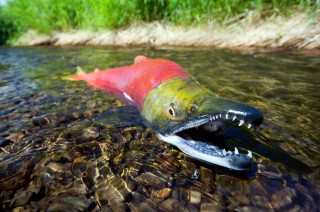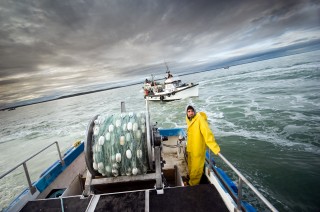Salmon lovers worldwide enjoy sockeye from Bristol Bay, Alaska—the world’s largest sockeye salmon fishery. Producing up to 70 million salmon each year, Bristol Bay supplies 40% of the world’s sockeye salmon to people across the globe. But, a massive gold and copper mine may cause Bristol Bay to top the list of global modern-day environmental casualties.

Today, the Bristol Bay region is a pristine wilderness stretching from the sweeping arc of the Alaska Range to the Bering Sea. It is home to a full array of Arctic wildlife including brown and black bears, wolves, waterfowl, whales, one of the world’s two freshwater seal populations, and the Mulchatna caribou herd—one of the largest in Alaska at 193,000 animals. The trout fisheries are also world-renowned, with some trophy rainbows reaching more than 30″ in size!
But it’s salmon that define the region. The salmon fisheries have long been an integral part of Alaska’s economy and have provided sustainable jobs, wild and culturally important food, tranquility and myriad other benefits to Alaskans and visitors for generations. This irreplaceable bay and its natural resources are now threatened by a massive open-pit gold and copper mine project known as Pebble, planned for the headwaters of Bristol Bay.
Pebble’s Potential Impact
Mine developers intend to dig a pit more than two square miles wide and two thousand feet deep, with a massive block-cave mine located nearby. From this pit they will extract and process over 10 billion tons of rock, enough to fill nearly a billion dumptrucks!
If developed, Pebble Mine will…
- be the largest open-pit mine in North America;
- create billions of gallons of mine waste housed in two 1,000-acre tailing ponds;
- have five dams to hold the tailing ponds in place, of which one will be taller than Hoover Dam at 740 feet high;
- require 35 billion gallons of local water per year; and
- be located in an active earthquake zone
Make no mistake—this would be one of the world’s largest mines located in one of its most pristine and productive places—it will have a global impact
A Diverse Coalition Forms to Stop Pebble
To address this massive threat, ACF is sponsoring an equally massive campaign that is bringing together Alaskans—commercial fishermen, sport fishermen, sport fishing guides, lodge owners, local businesses, Alaskan Native subsistence fishermen, citizens and local environmental groups to protect this global resource. ACF provides grants and support for campaign coordination, as well as funding for the campaign’s scientific, legal and media aspects.

Earlier this summer, a group consisting of ACF partners, six local tribes, commercial fishing groups, and the Bristol Bay Native Corporation—a powerful force in the region with 8,600 shareholders—asked the US Environmental Protection Agency (EPA) to invoke a rarely-used power that could block the Pebble Mine in the foreseeable future. Under section 404(c) of the Clean Water Act, EPA can close certain areas to permitting for projects that entail dredging up or filling in fragile and ecologically-rich wetlands and waterways. In Pebble’s case, this would prohibit the US Army Corps of Engineers from issuing permits for mine development in the Kvichak and Nushagak Rivers–effectively putting an end to the Pebble project.
EPA administrator Lisa Jackson traveled to Bristol Bay to meet with regional communities. Two days after Jackson heard local concerns, Alaska Congressman Don Young filed a bill seeking to strip EPA of its 404(c) power. ACF partner Nunamta Aulukestai’s Kim Williams says “I don’t know who Don Young is listening to, because he’s sure not listening to the people of Bristol Bay. He’s turning his back on the people.”
The EPA is expected to make a decision later this year. If the agency exercises its authority, a public review and comment period on the proposed mine would be held, during which this battle would heat up even more. However, if Don Young is successful, the Pebble permitting process will begin as scheduled next year, with the EPA powerless to respond.
Since the state of Alaska has never denied an application for development of a large mine, Pebble permitting will also create an infrastructure that would be leveraged by other mining efforts. Several companies are vigorously pursuing other mineral deposits near Pebble, raising the specter of even wider damage to the region and the wild salmon that make Bristol Bay world-renowned.
Empowering a Local Vision for Bristol Bay

For over a century outside interests have largely dictated the region’s future. To help the people of Bristol Bay determine their own course, ACF has issued one of the largest grants ever in its 30-year history for a project known as the Bristol Bay Regional Vision Project. The Bristol Bay Native Association (BBNA) is taking the lead on the project, which also includes Bristol Bay Native Corporation, Bristol Bay Economic Development Corporation, Bristol Bay Area Health Corporation and Bristol Bay Housing Authority. The partners have established a commission of respected leaders who are hosting meetings in all of the region’s villages. Discussions at the meetings focus on education, health, housing, energy, economic development and more.
From the findings, a preliminary report identifying shared values and issues will be developed. A final vision statement will be completed by Spring 2011, which will serve as a guide for future policy choices of the Bristol Bay Partners and other institutions in the region. Just as important, it will stand as a clear statement of the values and priorities of the people of the region and can be used as a measure to evaluate threats, such as Pebble Mine, from outside interests that may engage in the region in the future. Alaskans from all walks of life are hoping the EPA is listening, and will protect one of the world’s most precious natural areas. For more information visit www.savebristolbay.org.


